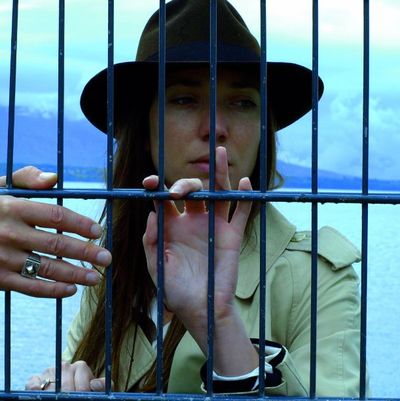
IÔÇÖve now seen Jean-Luc GodardÔÇÖs latest film twice, and I think I might be one more viewing away from finally being able to say what the hell itÔÇÖs about. That sounds like a condemnation, but a film you need to see again should be a film you want to see again, and the oblique beauty of Goodbye to Language, shot in 3-D, has a tractor-beam-like pull. ItÔÇÖs certainly not for everybody: This is Late Godard weÔÇÖre talking about, the type of film built around playful, confounding, seemingly random images and on-screen aphorisms. But it also shows him exploring some new territory, experimenting in new ways with 3-D and with what it can do to us. (More on that in a bit.) And so, for all its mysteries, Goodbye to Language has real power. ItÔÇÖs also brisk, clocking in around 70 minutes; you could catch back-to-back screenings before your friends even got out of Gone Girl.
The film presents us, as most Late Godard works do, with a collage-like series of shots and moments that donÔÇÖt feel like they belong in any linear order. We get news footage, random footage of nature, clips from old movies, home videos of a dog, staged scenes involving pseudo-characters. And, of course, lots of words, sometimes superimposed over each other. ┬áThe film has a structure ÔÇö or at least it pretends to. One section is called ÔÇ£Nature.ÔÇØ Another, ÔÇ£Metaphor.ÔÇØ But then suddenly it goes back to ÔÇ£NatureÔÇØ again. Along the way, Godard makes comparisons, contrasts, and other potentially relevant observations about images, technology, and the state of man. At a bookstand on the street, one pair of hands peruses books while two other pairs of hands silently trade iPhone screens back and forth. Someone quotes Solzhenitsyn, then tells someone else not to Google it. (You could Google a lot of the expressions in Goodbye to Language, of course; Godard is the master of cinematic quotation.)
For all the filmÔÇÖs opacity, GodardÔÇÖs overall theme is reasonably evident, since the film is called Goodbye to Language, and heÔÇÖs been chronicling the fragility of expression since his very first film. (Breathless was both a movie about misunderstanding and something of a misunderstanding itself; he had set out to make a crime drama and wound up creating a new film language.) As always in the directorÔÇÖs films, words and phrases transform into others, the filmic discourse starts and stops, breaks down, repeats; the center never holds. The mystery here lies in what Godard is actually saying, if anything, about this breakdown of language. At one point, someone expounds on the evolution of the thumb, right before we see peopleÔÇÖs thumbs briskly and quietly sliding across their mobile screens. At another point, someone notes that a Russian invented TV the same year Hitler was elected chancellor of Germany. Koinkydink? Do images and signifiers remove us from the real, keep us from truly confronting the troubles of the world? Someone keeps bringing up ÔÇ£Africa,ÔÇØ though theyÔÇÖre never able to go beyond that ÔÇö which itself seems to embody the limitation of words and of language. Later, Godard trots out references to Mary Shelley and Frankenstein, everybodyÔÇÖs go-to symbol for the horrors of modern technology.
ÔÇ£What they call images have become the murder of the present,ÔÇØ someone intones, and there is in fact a strange violence to the images Godard gives us. Sometimes the violence is just in the content: images of protest or war. Sometimes the violence is in the sound: Whenever we get a static or placid shot, Godard makes sure itÔÇÖs accompanied by absurdly squeaking pens or screeching children, or raspy, stilted narration (courtesy of Godard himself and his distinctly slurry speech) or other types of audio distortion. Sometimes the violence is in whatÔÇÖs been done to the image: Shots of nature are super-saturated and unreal, somehow both lovely and diseased.
And sometimes the violence is in whatÔÇÖs being done to us: Being Godard, he couldnÔÇÖt give two shits about the typical 3-D experience, so he superimposes his stereoscopic images, flips them, and stretches our eyesÔÇÖ ability to accommodate ÔÇö all the things youÔÇÖre not supposed to do with 3-D. In the filmÔÇÖs boldest visual experiment, a seemingly normal shot of two people is pulled in two directions, as one person walks away and one of the shots follows them, while the other stays put, and we try to stay focused on both. It feels like our eyes are literally being pulled apart. (During at least one of these moments, the characters are also naked, which makes us extra-complicit in our pain.) ItÔÇÖs agonizing and liberating at the same time.
ItÔÇÖs that interplay of fracturing and freedom that often distinguishes Godard and keeps him from becoming just another cinematic scold, telling the world that itÔÇÖs all wrong. The breakdown of language may not always be such a bad thing. What is the language of nature, after all? Running throughout is footage of a dog, Roxy (played by GodardÔÇÖs own dog, apparently), who might be the closest thing the film has to a protagonist, or maybe even an ideal ÔÇö blissfully free of the tyranny of signifiers and the technology that would undo them. ItÔÇÖs a beautiful gambit: Godard takes the basest form of the modern moving image (the online dog/cat video) and turns it into an expression of profound longing. ÔÇ£ThereÔÇÖs no nudity in nature,ÔÇØ someone tells us. ÔÇ£Animals arenÔÇÖt naked, because they are naked.ÔÇØ Our awareness and identification of the world keeps us from living in it. And so the dogÔÇÖs oneness with the world seems admirable, almost unattainable. It need not understand metaphor, yea though it be one.


